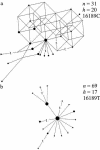The fingerprint of phantom mutations in mitochondrial DNA data
- PMID: 12384858
- PMCID: PMC385090
- DOI: 10.1086/344397
The fingerprint of phantom mutations in mitochondrial DNA data
Abstract
Phantom mutations are systematic artifacts generated in the course of the sequencing process itself. In sequenced mitochondrial DNA (mtDNA), they generate a hotspot pattern quite different from that of natural mutations in the cell. To identify the telltale patterns of a particular phantom mutation process, one first filters out the well-established frequent mutations (inferred from various data sets with additional coding region information). The filtered data are represented by their full (quasi-)median network, to visualize the character conflicts, which can be expressed numerically by the cube spectrum. Permutation tests are used to evaluate the overall phylogenetic content of the filtered data. Comparison with benchmark data sets helps to sort out suspicious data and to infer features and potential causes for the phantom mutation process. This approach, performed either in the lab or at the desk of a reviewer, will help to avoid errors that otherwise would go into print and could lead to erroneous evolutionary interpretations. The filtering procedure is illustrated with two mtDNA data sets that were severely affected by phantom mutations.
Figures




References
Electronic-Database Information
-
- Authors' Web site, http://www.stats.ox.ac.uk/~macaulay/fingerprint/index.html (table of mutational hits in HVS-I and program to calculate spectra)
-
- Brešar B, S. Klavžar S, Škrekovski R. Cubes polynomial and its derivatives. Available from http://citeseer.nj.nec.com/442937.html
-
- Shareware Phylogenetic Network Software, http://www.fluxus-engineering.com/sharenet.htm (for Network 2.1 and 3.1)
References
-
- Avise JC (2000) Phylogeography: the history and formation of species. Harvard University Press, Cambridge, MA
-
- Bandelt H-J, Forster P, Röhl A (1999) Median-joining networks for inferring intraspecific phylogenies. Mol Biol Evol 16:37–48 - PubMed
-
- Bandelt H-J, Lahermo P, Richards M, Macaulay V (2001) Detecting errors in mtDNA data by phylogenetic analysis. Int J Legal Med 115:64–69 - PubMed
Publication types
MeSH terms
Substances
Grants and funding
LinkOut - more resources
Full Text Sources
Other Literature Sources
Miscellaneous

